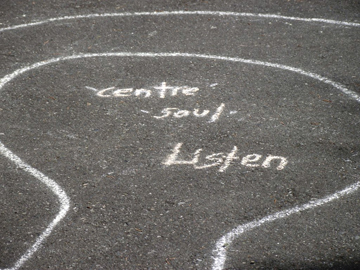Centering Prayer is an increasingly popular method of contemplative prayer or Christian meditation, placing a strong emphasis on interior silence. I’ve found it helpful when I’ve been disciplined to practice it every day, starting with a goal of 5 minutes each day of centered, silence. I freely admit that I’m not a spiritual expert or mystic on it, and I found the silencing of my mind and body to be liberating. The resting irony is that I don’t more actively seek such centered rest, peace and renewal; letting myself be distracted, divided and detoured by the chaotic urgencies of daily life that are essentially unimportant.
Though most authors trace its roots to the contemplative prayer of the Desert Fathers of early Christian monasticism, to the Lectio Divina tradition of Benedictinemonasticism, and to works like The Cloud of Unknowing and the writings of St. Teresa of Avila and St. John of the Cross, its origins as part of the “Centering Prayer” movement in modern Catholicism and Christianity can be traced to several books published by three Trappist monks of St. Joseph’s Abbey in Spencer, Massachusetts in the 1970s: Fr. William Meninger, Fr. M. Basil Pennington and Abbot Thomas Keating. (taken from the Wikipedia entry on “Centering Prayer”)
The practice of centering prayer may seem like it’s more of Buddhist or New Age meditation, an unChristian thing, and yet it’s a deep part of the tradition of following Jesus in a daily way. It’s merely another way of praying, of being centered, of listening for the word of God. The challenge of it is that Centering Prayer is less an exercise of concentrating, than it is a focusing of your attention on something (a word, a mantra) in order to shape the intention of consenting to God’s presence in our world, in our lives, in us.
Basil Pennington, one of the best known proponents of the centering prayer technique, has delineated the guidelines for centering prayer:
1. Sit comfortably with your eyes closed, relax, and quiet yourself. Be in love and faith to God.
2. Choose a sacred word that best supports your sincere intention to be in the Lord’s presence and open to His divine action within you (i.e. “Jesus“, “Lord,” “God,” “Savior,” “Abba,” “Divine,” “Shalom,” “Spirit,” “Love,” etc.).
3. Let that word be gently present as your symbol of your sincere intention to be in the Lord’s presence and open to His divine action within you. (Thomas Keating advises that the word remain unspoken.)
4. Whenever you become aware of anything (thoughts, feelings, perceptions, images, associations, etc.), simply return to your sacred word, your anchor.
(taken from the Wikipedia entry on “Centering Prayer”)
It may – or may not – work for you as a prayer discipline. If it does great. How is it that you seek to be aware of God’s presence in your life and day?
